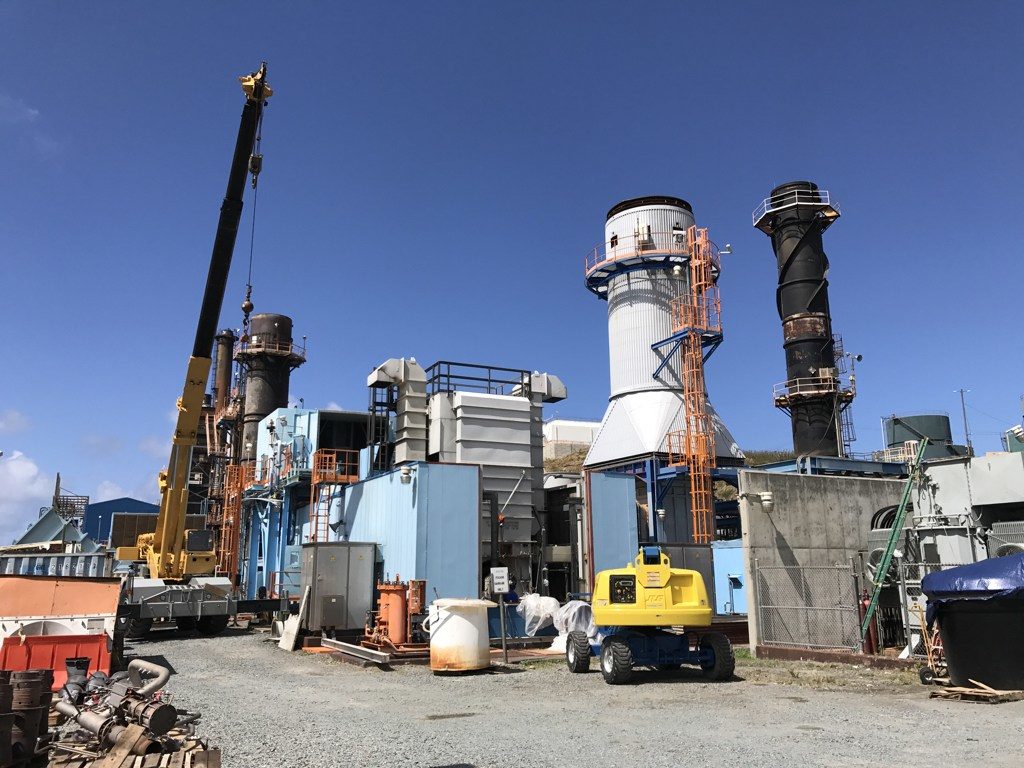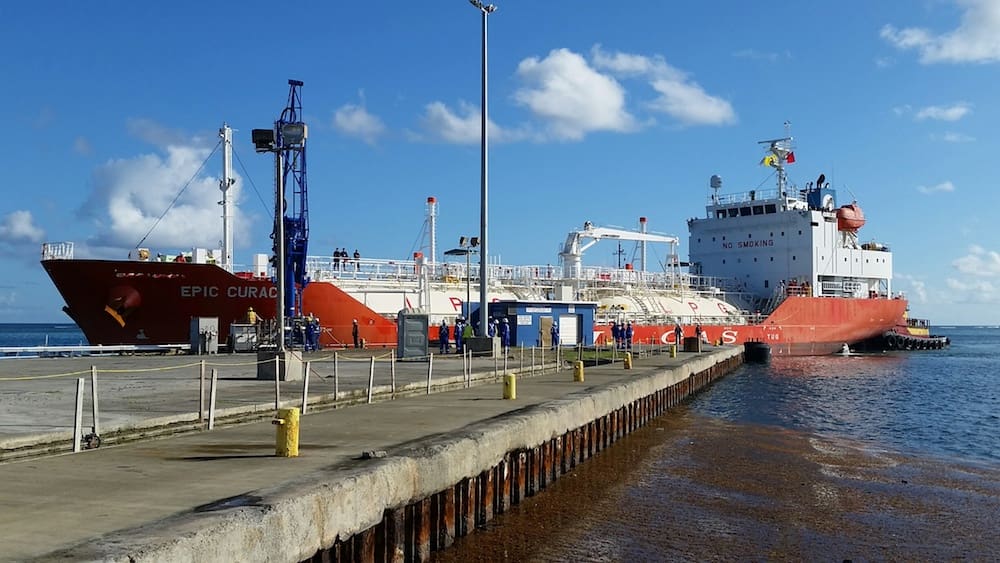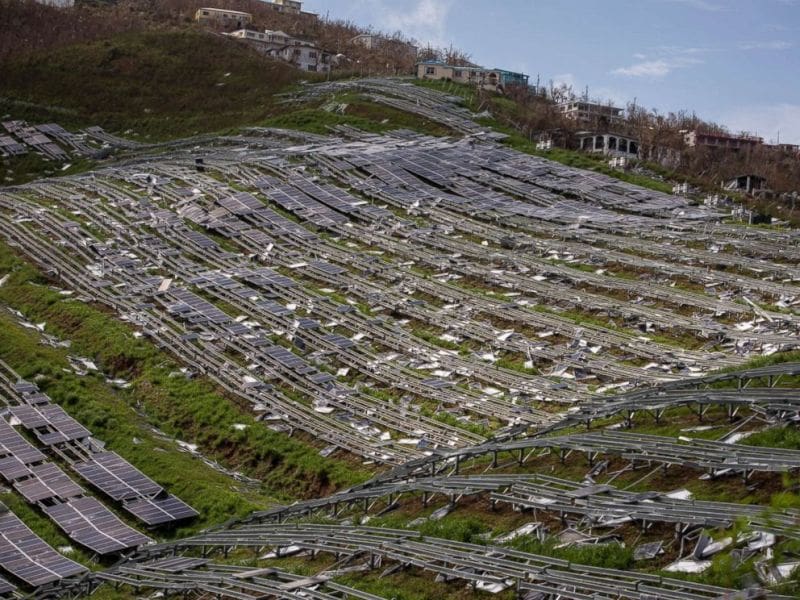
Concurrent with Alpine Energy Group’s demise, Hovensa refinery announced on short notice it was ceasing operations on St. Croix in early 2012. The refinery, which had been in operation since 1974, initially as Hess Corporation, was the territory’s largest employer. The blow to the community and its 1,000 or more employees was harsh. The double whammy was WAPA’s immediate inability to purchase fuel oil at cost.
The loss of Hovensa’s oil to WAPA and thus the ratepayers equaled $50 million, according to a 2015 report to then Gov. Kenneth Mapp during his transition into Government House. Along with having to pay market prices, WAPA was also suddenly exposed to complex logistics and market volatility.
Left with a whole new set of unexpected problems, then-WAPA Chief Executive Officer Hugo Hodge was forced to act quickly.
A year-and-a-half later in July 2013 the authority entered into a seven-year power purchase contract – which later became a 10-year agreement – with Vitol Virgin Islands Corp to convert seven of WAPA’s gas generators to propane. The conversion to propane was expected to reduce fuel costs by 30 percent. The partial use of the propane was also expected to reduce greenhouse gas emissions by 20 percent.

The anticipated cost to WAPA and therefore the ratepayers was $87 million. Once work began, a long list of unforeseen problems arose. On St. Thomas, the excavators hit solid granite where the tank pads were to be placed, and WAPA had to relocate the site; on St. Croix adverse soil conditions led to more work than anticipated.
High concrete prices and lack of adequate supplies, larger slabs for the propane tanks due to seismic activity, fenders, breasting dolphins, pilings for the earthwork required to hold the tanks and a host of other unanticipated physical impairments plagued the project from the beginning. As a result, the cost soared to $160 million along with the interest rate on the loans from Vitol to 14 percent.
WAPA CEO Lawrence Kupfer said in a recent conversation that the surprises noted above were the result of the Vitol deal going forward without detailed engineering plans. In its rush to get the bills down for Virgin Islanders, WAPA could not afford the two to three year delay those additional plans would have caused. So, in the end, Kupfer said, the construction and the plant was a lot more costly.
WAPA’s Part: Denial, Impaired Listening and Bad Decisions
On the long road to today, the six or seven executive directors, upper management and the board have over the last 20 years played a significant role in the dire state of the utility, according to several knowledgeable insiders.
Listening to the Public Service Commissioner’s advice over their own employees was a mistake, according to a well-informed former official, who said WAPA in many cases listened to the PSC when it shouldn’t have.
Somewhat contradictorily, several reliable sources also verified that PSC consultants took much of their information from employees, distilled it and reported it back to the PSC and WAPA.
One of the issues, more than a few sources said, was choosing to rent new, smaller generating units – as recommended by the consultants – rather than repair the six or more (some relatively new) generating units that were moth-balled. This is part of the contradiction. Employees who spoke on the condition of anonymity said that refitting the older, WAPA-owned units would have been dramatically more cost effective.
Going with the smaller, more efficient units – which were rented, not owned – recommended by the consultants belies the notion that the consultants always took advice from WAPA rank and file employees.
As to the general failure of authority executives to listen to the people who work there, two current employees recently laid out the issue in a lawsuit alleging they had suffered harassment after reporting their findings to the WAPA board of directors. The suit, filed in U.S. Virgin Islands Superior Court, stated that the pair had watched as WAPA’s leaders made “economically incorrect decisions” that had cost the community dearly.
Though the employees’ jobs involved cost analysis of decisions made at the top, they were rarely asked to present their findings to the board. And when they were finally asked and did so, they fell under constant scrutiny, subjected to harassment including being openly laughed at, the lawsuit documents said.
As for denial, other employees and a former WAPA executive said that along the way, WAPA officials did not acknowledge there were serious problems, even though rank and file employees knew better. Some employees left as a result.
Compliance
Despite the disagreements, public battering and internal hearing loss, WAPA did comply with some effective suggestions.
In 2006, the PSC suggested in a press release the following cost-saving remedies:
– a heat recovery steam generator on St. Croix, with an estimated cost savings of $30 million annually
– improving current fuel efficiency in WAPA’s generating capacity
– reducing line losses through unbilled services, poor equipment and theft
Those suggestions were in line with Interior’s inspector general report three years later which recommended work be completed on the heat recovery steam generator on St. Croix, which it was; and that maintenance be stepped up on the aging equipment, which was challenging given the cost of fuel that was not covered by the LEAC. In its report, the inspector general acknowledged that the PSC’s periodic refusal to up the LEAC to meet the bills coupled with the ongoing government arrears were the core factors in the authority’s abysmal maintenance record.
One suggestion that was successfully carried out was WAPA pressing for a 14 cent fuel tax that would be fed to the authority to purchase new, energy efficient generating units and/or heat recovery steam generators in both districts.
In 2012, the Senate approved raising the fuel tax from seven cents to 14 cents. The tax went into effect in July of that year. The Mapp transition report showed that the increase in fuel tax more than doubled revenues in the following year.
With the heat HRSGs purchased, installed and operational in both districts, some relief was realized.
Fuel efficiency was addressed through the propane project and a variety of public-private partnerships that resulted in solar farms in both districts among other remedies.
Then came hurricanes Irma and Maria, which completely wiped out the farm on St. Thomas and contributed to financial upheaval after the storms. As mentioned in an earlier report, FEMA funds cannot be used to restore privately owned projects.

Many suggestions from a variety of entities were implemented by WAPA over the years. And many mistakes were made on all sides. Reality dictates the past cannot be undone, but knowledge of history can provide an opportunity to not make the same mistakes again.
Conclusion
“We work with human weakness itself, the most powerful drug of all. The universal hunger for security, easy answers, magic and someone to blame.” – from Mickelsson’s Ghosts by John Gardner.
The enormous complexity of the workings, failures and decades of kicking the can down the road relative to Water and Power Authority, coupled with years of benign neglect, political maneuvering, unpaid bills by government and hospitals along with deliberate obfuscation, leaves no easy answers at this point. Likely, given the unique circumstances and geographic realities of the USVI, there never were any easy answers.
Some suggestions that might curtail history repeating itself were considered good ones by several individuals interviewed for this series. One such suggestion taken directly from the 2018 WAPA Cluster Report strongly recommends getting rid of the consultants:
“We should immediately terminate virtually all of the consultants that have continuously received money from WAPA and the PSC, as little to none of their advice has produced positive results for the V.I.”
Another suggestion in the same report is to reconfigure the PSC as it currently exists.
“There should be other considerations given to how the PSC should function as there are many models,” the report suggests. “One recommendation is a utility commission that represents all stakeholders. This would funnel all concerns to a central entity that would coordinate with the utility as a quasi-judicial body outside of the political process. This would require a legislative remedy but would also protect the utility from ad hoc policy developed out of political posturing.”
Even the rating companies can see from a distance how the PSC feeds the problem. In downgrading WAPA recently, Fitch laid their decision at the feet of the PSC and its failure to approve the three percent increase the authority requested in order to refinance its current debt. As WAPA stated in the hearing, the increase was needed to restructure its debt thereby providing the breathing room to develop a grid that would include far less costly renewables.
In 2010, the authority was given a “stable” rating by two of the three rating agencies, Standard and Poor’s and Moody’s. Coincidentally, the stable ratings coincided with the authority being granted an 11 percent LEAC increase from the PSC.
The decadeslong dreary drama of LEAC requests, denials and misrepresentations of the simple pass-through fuel charge clearly suggests the need for some kind of PSC restructuring.
As for consultants, one of the repeated refrains heard while compiling this report was the need for submission of a request for proposals for a consultant or consultants. This is a routine procedure in government contracts designed to refresh the reporting process while potentially lowering costs.
The 2018 report provides a wealth of other facts and suggestions far too numerous and technical to properly condense here. Fortunately it is readily available from the links provided in the four reports on WAPA’s history.
A recent comment on a Source story about Kupfer’s response to what he deemed misinformation introduced by Delegate to Congress Stacey Plaskett addresses one of the major stumbling blocks aside from the many outlined previously in this series. “Action plans and activity mean nothing to the citizens of the USVI. We make the measure of WAPA based upon the results of power availability and cost in our homes and community,” the contributor wrote.
The comment highlights one of the greatest problems facing the utility, and by association the ratepayers – the notion that “action plans and activity mean nothing.”
Therein lies one of the most frustrating attitudes that, while serving no one, becomes some sort of meme passed like a virus through the community.
Citizens continue to live in a vacuum of misinformation, listening, as the senators did when they turned down the Alpine deal, to bloviators instead of professionals who actually know the energy business.
So many of the worthwhile long- and short-term plans, and accompanying activities, have been shouted down by folks beset by the “universal hunger for security, easy answers, magic and someone to blame.”
It should be clear at this point there are no easy answers, certainly no magic and blaming has led nowhere except to despair and demoralization. When all is said and done, the adage that comes to mind is the definition of insanity: doing the same thing over and over while expecting different results. Results are what the territory desperately needs. Now we know what the same behaviors over and over have wrought. The answers exist, as do many innovative opportunities, from new technologies to new attitudes. If the community wants different results, then knowing the history of behaviors could lead to a new day, but, realistically, not without the accompanying pain.
Bill Kossler and Kelsey Nowakowski contributed to this report.
Earlier Installments:
Melee and Missed Opportunities: A Short History of WAPA Part I
The Power Players: A Short History of WAPA Part II
Fact and Reality Check: A Short History of WAPA Part III





